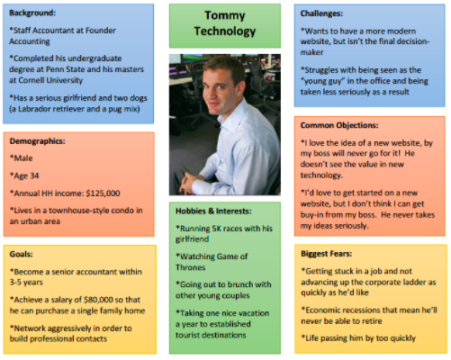
How to create a customer persona
Use our free tool to create customer personas, the building blocks of successful marketing strategies.
The slider walks you through the process, then generates a four color one sheet you can use immediately, to inform new employees, designers and marketers about who your customer is and what they want.
So what is a customer persona?
A customer persona is simply an imaginary person created to replicate a typical purchaser.
The format is a condensed, one page description of a sample client, who is actually an aggregate.
Customer personas allow team members to fully understand the customer on a human and emotional level, even when the sale is highly analytical.
They are so powerful as a foundational element of marketing that companies like Vendasta, whose marketing powered rocket-ship growth of 50% year over year for the last three years, hands them to every new marketing employee.
While a few marketers are extremely intuitive about messaging, best practice is not to rely on genius when you can share accurate intelligence with your team.
Which persona should you add first?
We recommend starting out by creating the most obvious persona that your sales team already understands. Then segment your customers into large and small, and into different verticals.
For example, if your company develops marketing software, it may license the platform both to local media and to digital agencies, some small, some very large. Make a short list of the groups your customers tend to fall into.
What will you be asked about your customers?
The basic information is title, company size, age, education, and then delves more deeply into motivators and concerns.
The meat: Adding customer goals
What are key goals they are tasked with this year, long term? How will they measure success? Will it be a revenue goal, a cost-saving goal, a productivity goal or a competitive alignment? The Persona Machine will help you walk through and share critical motivators.
The potatoes: Adding challenges and fears
Just as important as motivators are your customers challenges and fears. Your team needs to be able to recite by heart the customers challenges and obstacles to purchase.
What slows down on the job? What are their top obstacles to making purchases, or making a purchase from your company versus a competitor? Which competitors are they likely to be talking to?
What are they looking at for information?
Once your content and advertising teams are on message, it is equally important to distribute these messages on the platforms that your customers are using for trade information.
Which associations, blogs, social networks and trade media are they reading? Who else do they rely on internally or externally for recommendations?
The image
The last important piece of the Persona Machine is uploading an image. Your customer’ images convey a variety of demographic and emotional information.
We have one huge rule about images: please start with real photos of customers, before going to Google images for a fashion shot. Don´t guess. Don’t visualize who your customers are without seeing them. Rather, obtain real images, even if you cannot use them in internal materials, you will be way ahead go the game.
We looked for images of brand loyalists at the VP levels in corporate local media – that is, people who control hundreds of millions in revenues and can make or break a software company. These are real images of these VP´s from case studies this month on LocalMediaInsider:

 [
[


How do you get the information
There are a number of ways to obtain information that makes a customer persona into a critical building block for marketers, versus a random guess.
A quick and dirty way is to bring a lap-top or mobile device into a sales meeting and fill out the form with sellers over muffins or pizza.
Maybe you also want to bring in support teams that take customer calls. Have some fun discussing your customers personalities!
What if you need more data
There are other ways to create data on your customers. One technology company had an intern make a list of top ten customers – i.e., the actual people who managed purchases – and looked them up on Facebook and LinkedIn to create a spreadsheet, which was then used to create a composite.
He was able to identify a variety of data points, including job title, educational background, last few jobs, age and male versus female, to feed into the aggregated model.
If the customer type needs a more detailed analysis, an email survey with a phone follow-up can do the trick. If your company needs custom survey support please let us know at the end of this article.
Need more help? We are committed to helping journalism based media connect with transformative technology.






Comments are closed.